Yes ! Several things are totally wrong by usual stripping methods.
1 The Wee Lassie is a tough boat to strip, but you can do it.
2 You didn't follow Canoecraft. Did you bead and cove your strips ?
3 Should have started at the shear, and stayed with it.
4.There is a method called the herringbone pattern. The strips are joined at the middle . Thus strips that are half the length of the canoe can be used. Trying doing a search.
Now what you really want to know, is can you finish this canoe, without tearing it apart ? Yes. It will take you longer, but you will get there ! You will become an expert at fitting strips, by the time you are done ! Don't give up! Many builders go with totally off the wall stripping methods. Some turn out great, some don't. They all float.
The wood in a stripper is just a form ! The fiberglass will give it the strength. If you have a very thin hull, put two layers of cloth on the bottom.
The Wee Lassie, is in my opinion, one of the best canoes out there ! It is sea worthy, and a joy to paddle. Double blade or single. I've built several over the years, and plan to build another soon
The Lassie requires some tough twisting of the strips. Look for ways to hold the strips in place. Staples, clamps, nails if you have to. Some use a heat gun to help twist strips. I haven't done this, try on some scrap first, if you want to try it. Once you have covered the stem forms, usually it gets easier. Maybe not with your current approach. But stay at it !
Don't give up !
Jim













